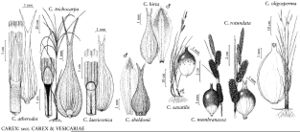Carex hirta
Sp. Pl. 2: 975. 1753.
Culms trigonous in cross section, (10–)20–90 cm. Leaves: basal sheaths brown, reddish purple tinged, inner bands slightly fibrillose with age; sheaths spreading pubescent; ligules 2–8(–10.5) mm; blades spreading, 2.5–8 mm wide, pubescent, not papillose abaxially. Inflorescences 8–50 cm; spikes erect or ascending; proximal (1–)2–3 spikes pistillate; terminal 1–3 spikes staminate. Pistillate scales ovate, apex acute to acuminate, scabrous-awned, sparsely spreading-pubescent or glabrous. Staminate scales ovate, apex obtuse to acuminate, shortly scabrous-awned except sometimes the proximal, sparsely to densely spreading-white-pubescent. Perigynia 12–20-veined, 4.8–7.8 × 1.7–2.5 mm, ± densely spreading-pubescent; beak 1.5–2.7 mm, spreading-pubescent, teeth spreading, 0.8–1.7 mm. 2n = 112–114.
Phenology: Fruiting Jun–Aug.
Habitat: Dry to wet fields, ditches, roadsides, railroad embankments, disturbed stream banks, lakeshores, and open forests
Elevation: 0–600 m
Distribution

N.S., Ont., P.E.I., Que., Conn., Maine, Md., Mass., Mich., N.J., N.Y., Pa., Wis., Eurasia, introduced New Zealand.
Discussion
Carex hirta was first collected in North America in 1877 in Amherst, Massachusetts, and in 1878 in Philadelphia, Pennsylvania. Completely glabrous forms, known from Eurasia, have not yet been found in North America.
Selected References
None.
